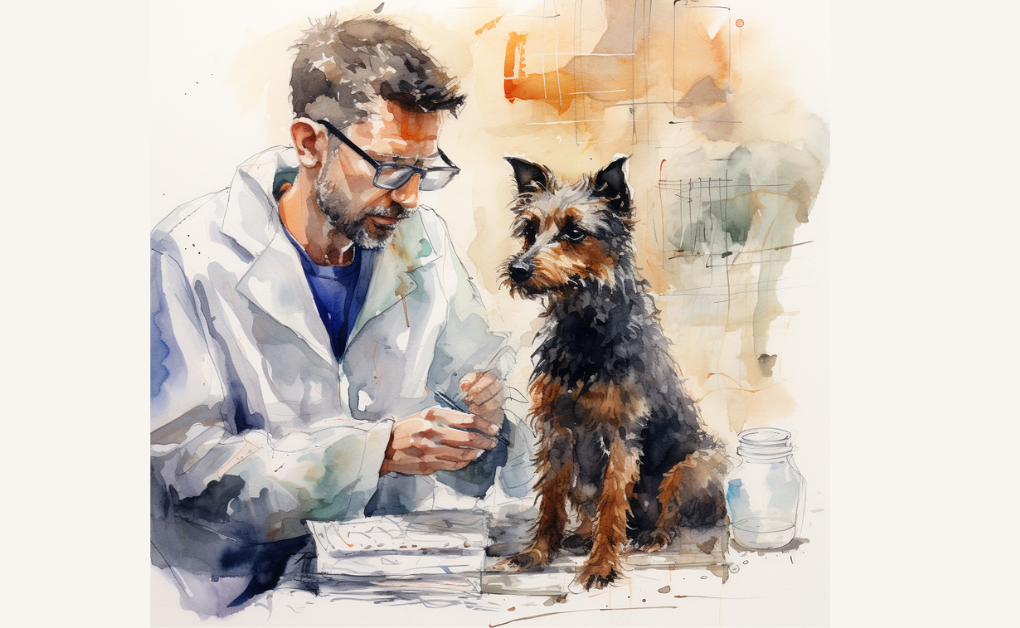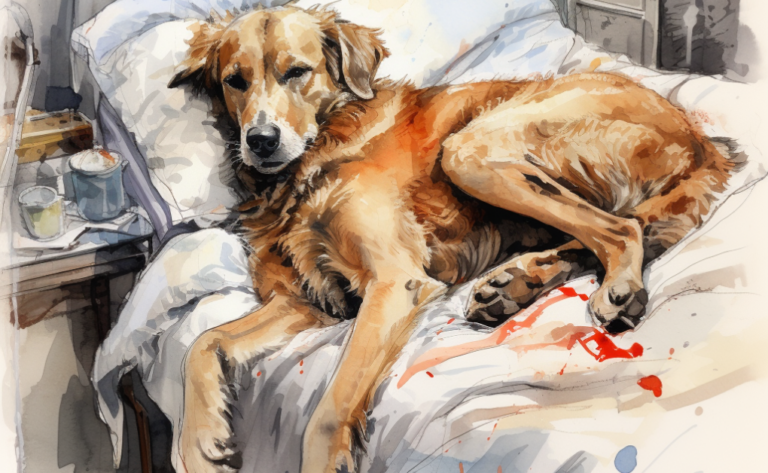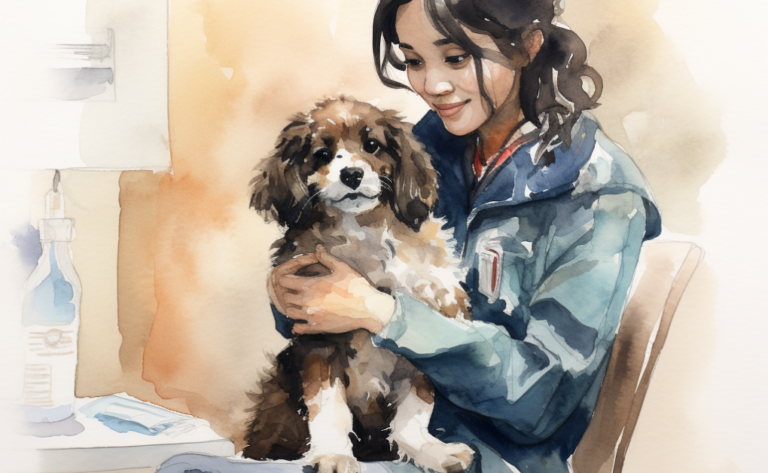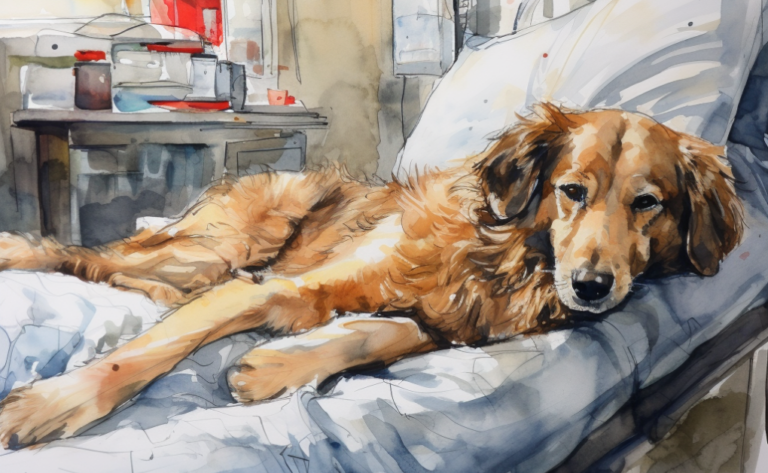Uveitis in Dogs: Causes, Symptoms, Diagnosis, Treatment
What is it?
How is it Treated?
Breed Predispositions
Bullmastiffs, Cocker Spaniels, Beagles, German Shepherds, Labrador Retrievers
Introduction
During a lazy Sunday afternoon, Emily was snuggling with her cherished Greyhound, Luna, when she noticed that Luna’s eye appeared red and swollen. Alarmed by this unexpected development, Emily quickly recognized that her beloved pet needed professional care and took her to the veterinarian. After a detailed examination, the vet diagnosed Luna with uveitis, an inflammatory eye condition that can affect dogs.
Uveitis is a common inflammatory condition that impacts the uveal tract in dogs and cats, which includes the iris, ciliary body, and choroid. These elements are vital to the eye’s basic anatomy, performing crucial functions like delivering blood and nutrients to the eye and managing the amount of light that enters by adjusting the size of the pupil. Uveitis, in essence, is inflammation of this uveal tract and can result in discomfort, redness, sensitivity to light, and even vision impairment.
The condition can affect various breeds, including Golden Retrievers, which may be prone to issues like uveal cysts. These cysts can contribute to uveitis by causing complications in the eye’s anterior chamber. If uveitis remains untreated, it may increase intraocular pressure, resulting in more severe eye problems or even blindness.
Types of Uveitis in Dogs
There are several types of uveitis in dogs, which can be classified based on various factors, such as the part of the eye affected, the duration of the inflammation, or the underlying cause. Some common types of uveitis in dogs include:
Anterior Uveitis
Anterior uveitis in dogs is an inflammatory condition affecting the front of the uveal tract, including the iris and the ciliary body. It is the most common form of uveitis in dogs and can be caused by various factors such as infections, immune-mediated disorders, or trauma to the eye. Early diagnosis and treatment are crucial to prevent complications, including glaucoma, cataracts, or permanent vision loss.

Posterior Uveitis
Posterior uveitis in dogs is an inflammatory condition affecting the back of the uveal tract, including the choroid and retina. This form of uveitis is less common than anterior but can be more challenging to diagnose and treat. Causes can include infections, immune-mediated disorders, or neoplasia. Early diagnosis and treatment are essential to prevent complications such as retinal detachment or blindness.
Panuveitis
Panuveitis in dogs is a severe inflammatory eye condition that affects all parts of the uveal tract, including the iris, ciliary body, and choroid. This form of uveitis can result from various causes, including infections, immune-mediated disorders, and neoplasia. Symptoms often include redness, swelling, pain, light sensitivity, and vision problems. Due to the widespread inflammation, panuveitis can lead to severe complications such as glaucoma, cataracts, and even blindness if not treated promptly.
Granulomatous Uveitis
Granulomatous uveitis in dogs is a specific form characterized by the formation of granulomas, which are small nodular clusters of inflammatory cells. This type of uveitis is typically a chronic, slow-progressing condition that can be challenging to treat. Various factors, including infections, immune-mediated disorders, and neoplastic diseases, can trigger granulomatous uveitis.
Non-granulomatous Uveitis
Non-granulomatous uveitis in dogs is a form of uveitis that does not involve the formation of granulomas, which are small nodular clusters of inflammatory cells. This type of uveitis usually presents as an acute condition with sudden onset and potentially rapid progression. Various factors, including infections, immune-mediated disorders, and trauma, can cause non-granulomatous uveitis.
Infectious Uveitis
Infectious uveitis in dogs is an inflammation of the uvea, the middle layer of the eye, caused by various infectious agents such as bacteria, viruses, fungi, or parasites. This type of uveitis can lead to severe eye pain, redness, sensitivity to light, and vision problems. If left untreated, infectious uveitis can result in complications like glaucoma, cataracts, and even blindness.
Identifying the specific type of uveitis in dogs is crucial for determining the appropriate treatment and managing the underlying cause of the inflammation.
Causes of Uveitis in Dogs
Uveitis in dogs is an intraocular inflammation affecting the uveal tract, comprising the iris, ciliary body, and choroid, integral structures of the eye. This condition can be caused by numerous factors, including:
- Infectious diseases: These could be bacterial, viral, or fungal infections such as leptospirosis, Lyme disease, canine distemper, toxoplasmosis, and ehrlichiosis. These infectious causes of uveitis can trigger a significant response in the eye.
- Immune-mediated diseases: Autoimmune disorders, where the dog’s immune system wrongfully attacks its tissues, can lead to uveitis. Examples include systemic lupus erythematosus, rheumatoid arthritis, or immune-mediated polyarthritis. In some cases, uveitis secondary to immune-mediated diseases can be diagnosed.
- Cancer: Inflammation and uveitis can result from neoplasia or cancer, whether it originates in the eye or spreads from other body parts.
- Trauma: Traumatic injuries to the eye, such as from blunt force or penetrating trauma, can result in secondary uveitis.
- Metabolic disorders: Certain metabolic disorders like diabetes mellitus or hyperlipidemia can cause eye inflammation, contributing to uveitis development.
- Lens-induced uveitis: If a lens ruptures or leaks, lens-induced uveitis can occur due to the leakage of lens proteins, which induces an inflammatory response. This can lead to issues like cataracts or secondary glaucoma due to the increased pressure from the aqueous humor of the eye, which is the fluid that produces fluid inside the eye.
- Pigmentary Uveitis: This form of uveitis is a specific concern in certain breeds and leads to chronic uveitis if left unattended.
- Idiopathic: Despite extensive diagnostic investigations, the possible causes of uveitis might sometimes remain unknown. This is referred to as idiopathic uveitis.
Identifying the systemic cause or possible causes of uveitis in dogs is crucial for providing appropriate treatment and preventing further complications. Consequently, veterinarians will conduct a thorough examination, including laboratory tests and imaging, to identify the cause and develop an appropriate treatment strategy.
Symptoms of Anterior Uveitis in Dogs
Clinical signs of uveitis in dogs, which is an ocular inflammation affecting the anterior portion of the uveal tract, can manifest as:
- Redness
- Pain:
- Swelling
- Discharge
- Cloudiness
- Constricted pupil
- Tearing
- Change in eye color
- Decreased vision
- Lethargy
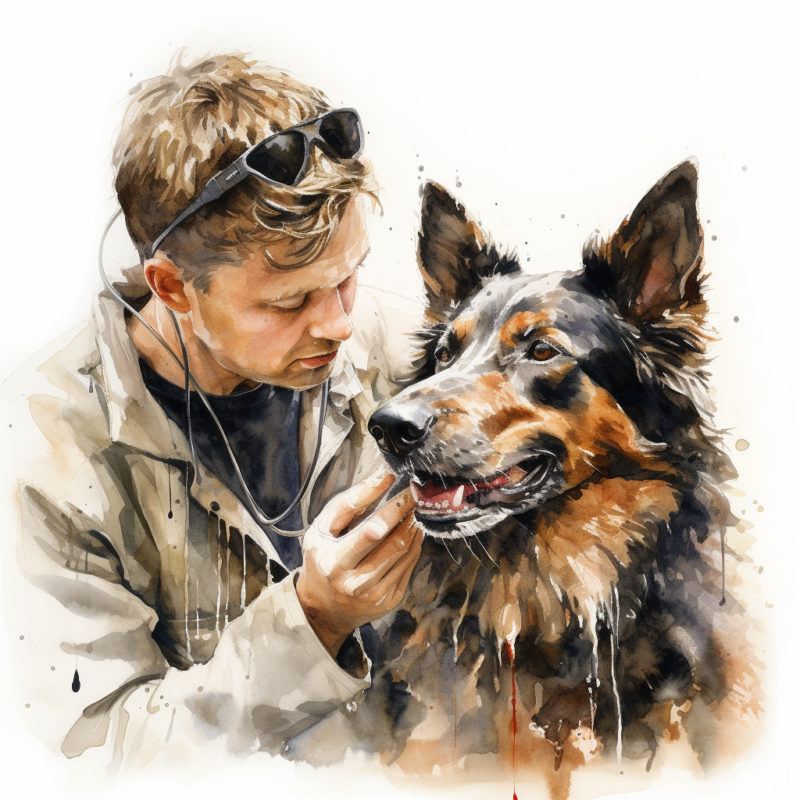
Promptly contacting a veterinarian is crucial if you notice any of these symptoms in your dog. Swift diagnosis and treatment can mitigate complications and enhance the prognosis for dogs suffering from this inflammation of the uveal tract.
Diagnosis of Uveitis in Dogs
A veterinarian will carry out an exhaustive examination of a dog’s eyes and scrutinize its medical history to diagnose uveitis. This process is an integral part of veterinary ophthalmology, aiming to better understand the disease in dogs. In addition, the vet may inquire about recent illnesses, injuries, or any exposure to potential triggers of uveitis. The diagnostic journey may encompass the following:
Eye Assessment
The veterinary professional will visually inspect the dog’s eyes for signs of inflammation, redness, or discharge. They will also evaluate the dog’s vision and light responsiveness.
Slit-lamp Biomicroscopy
Using a specialized device known as a slit-lamp biomicroscope, the vet can closely scrutinize the front part of the dog’s eye, including the cornea, iris, and lens. This examination aids in assessing the severity of inflammation, identifying any corneal edema, and discovering potential causes or complications.
Measurement of Intraocular Pressure
The veterinarian will use a tonometer to gauge the pressure within the dog’s eye. A rise in intraocular pressure can indicate inflammation or other underlying conditions that might contribute to uveitis, like secondary glaucoma in dogs.
Ophthalmoscopy
The vet uses an ophthalmoscope to inspect the back of the eye, particularly the retina and optic nerve. This step helps to pinpoint any irregularities or signs of inflammation in these areas, detect possible lens luxation, or even identify retinal detachment.
Blood Analysis
Blood samples from affected dogs may be drawn to identify underlying infections or systemic diseases that could cause uveitis. Comprehensive tests like a complete blood count (CBC), blood chemistry panel, and specific tests for infectious diseases such as Lyme disease, toxoplasmosis, or leptospirosis may be part of this process.
Ocular Ultrasound
Ocular ultrasound may examine the eye’s internal structures in specific scenarios, determining any possible causes of uveitis, such as tumors or other irregularities.
Biopsy or Cytology
Occasionally, the vet may suggest a biopsy or cytology of the eye tissues to uncover the underlying reason for inflammation, noting the types of cells present in the eye.
Once uveitis is diagnosed, treatment can be administered promptly, as uveitis is usually a condition that necessitates swift medical attention.
Treatment of Uveitis in Dogs
Treatment for uveitis in dogs is focused on addressing the underlying cause, controlling inflammation, and alleviating pain. The specific treatment plan will depend on the cause and severity of the condition. Some of the standard treatment options include:
Medications
Topical or oral anti-inflammatory medications, such as corticosteroids, may be prescribed to reduce inflammation and alleviate pain. These medications used to treat uveitis in dogs aim to address the underlying cause, control inflammation, and manage pain. The prescribed medications will depend on the cause and severity of uveitis and the dog’s overall health. Some common types of medicines used to treat uveitis in dogs include:
- Anti-inflammatory medications: These medications help reduce inflammation within the eye. Nonsteroidal anti-inflammatory drugs (NSAIDs) like carprofen or meloxicam may be prescribed, and corticosteroids like prednisolone are generally more potent in controlling inflammation.
- Immunosuppressive drugs: In cases where uveitis is caused by an immune-mediated condition or when corticosteroids are not effective enough, immunosuppressive medications such as cyclosporine or azathioprine may be used to help control the immune response and decrease inflammation.
- Antibiotics or antifungal medications: If a bacterial or fungal infection causes uveitis, the veterinarian will prescribe appropriate antibiotics or antifungal medications to treat the disease.
- Antiviral medications: In cases of viral-induced uveitis, antiviral medications like famciclovir or acyclovir may help control the viral infection.
- Pain relief medications: Pain management is essential in cases of uveitis, and medications like opioids or additional NSAIDs may be prescribed to help manage pain and discomfort.
- Topical medications: Topical eye drops or ointments may be prescribed to relieve pain, inflammation, and dryness. These medications may include artificial tears, lubricating ointments, or medicated drops containing antibiotics, corticosteroids, or other anti-inflammatory agents. Some everyday eye drops prescribed for uveitis in dogs have:
- Anti-inflammatory eye drops
- Atropine eye drops
- Antibiotic eye drops
- Antiviral eye drops
- Cycloplegic eye drops
It is essential to follow the veterinarian’s instructions and administer all prescribed medications as directed. The vet may need to adjust the treatment plan based on the dog’s response to the drugs and the condition’s progress.
Dilating Agents
Veterinarians use dilating agents, also known as mydriatic and cycloplegic agents, to help manage uveitis in dogs. The most common dilating agent used in treating uveitis is atropine. These agents work by causing the pupil to dilate and the ciliary muscle to relax, which helps alleviate pain, discomfort, and inflammation in the eye.
When treating uveitis in dogs with dilating agents, the veterinarian will usually prescribe atropine eye drops or ointment. The vet will provide instructions on how often to administer the medication, which could be anywhere from once to several times a day, depending on the severity of the condition.
Using dilating agents such as atropine can have several benefits for dogs with uveitis:
- Pain relief: Relaxing the ciliary muscle and stabilizing the inflamed iris, atropine can help reduce pain and discomfort in the affected eye.
- Prevention of synechiae: Dilating the pupil can prevent the formation of adhesions (synechiae) between the iris and the lens, which can occur in severe cases of uveitis and lead to complications such as glaucoma.
- Reduced inflammation: Dilating the pupil helps decrease the inflammatory response in the eye, which can help alleviate the symptoms of uveitis.
Following your veterinarian’s instructions when administering dilating agents to your dog is essential, as improper use or overdose can lead to side effects or complications. In addition, always consult your veterinarian if you have concerns about your dog’s condition or if the symptoms worsen despite treatment.
Treatment of Underlying Conditions
To effectively treat uveitis in dogs, it is crucial to address the underlying cause. Once the underlying cause has been identified, the veterinarian will prescribe an appropriate treatment plan to manage the uveitis and address the root cause.
Here are some common underlying causes of uveitis and their respective treatments:
- Infections: If the uveitis is caused by a bacterial, viral, or fungal infection, the veterinarian will prescribe appropriate antibiotics, antiviral, or antifungal medications to treat the infection. Following the prescribed dosage and duration is essential to manage the infection adequately.
- Autoimmune diseases: If the cause is an autoimmune disorder, such as immune-mediated polyarthritis or systemic lupus erythematosus, the vet may prescribe immunosuppressive drugs like corticosteroids or other medications to manage the immune response and reduce inflammation.
- Trauma or injury: If the uveitis is due to an injury to the eye, the veterinarian will first address the injury by cleaning, suturing, or providing other necessary treatments. They may prescribe pain medication and antibiotics to prevent infection and manage pain.
- Tumors: If a tumor is causing the uveitis, the veterinarian will discuss treatment options, which may include surgery, chemotherapy, or radiation therapy, depending on the type and location of the tumor.
- Metabolic disorders: If the uveitis is due to a metabolic disorder like diabetes or Cushing’s disease, the veterinarian will provide appropriate treatment and management options to address the underlying condition.
- Parasites: If parasites are causing the uveitis, the veterinarian will prescribe appropriate antiparasitic medications to eliminate the parasites.
While treating the underlying cause, the veterinarian will also manage uveitis symptoms using anti-inflammatory drugs, pain-relief medications, and dilating agents. Following your veterinarian’s instructions and attending regular check-ups is crucial to ensure the treatment plan is effective and monitor your dog’s progress.
Surgery
Treating uveitis mainly involves managing inflammation and targeting the root cause. Nevertheless, surgical interventions may be necessary in severe instances or when non-surgical treatments fail to alleviate the condition. Here are some potential surgical procedures:
- Cataract Surgery: If uveitis has prompted the formation of cataracts, cataract surgery, performed by a veterinary ophthalmologist, may be carried out to reinstate vision. This procedure entails the removal of the clouded lens, often replacing it with an artificial substitute.
- Glaucoma Surgery: Uveitis might lead to glaucoma, a condition typified by escalated pressure within the eye, compromising the uveal tract and creating a barrier between the eye and the fluid from the eye. Various surgical procedures, such as trabeculectomy or drainage device placement, may be required to alleviate this pressure and protect the optic nerve.
- Vitrectomy: In particular scenarios, significant inflammation in the vitreous humor (the transparent gel filling the space between the lens and the retina) may necessitate a vitrectomy. This operation involves the extraction and replacement of the vitreous.
- Enucleation: Enucleation or removing the eye might be deemed necessary in the most severe cases where the eye is drastically affected, causing unbearable pain with no chance of restoring vision. Often, a cosmetic prosthetic eye can be inserted post-enucleation.
It’s worth mentioning that the need and selection of surgical intervention hinge on numerous factors. These include the severity and cause of uveitis, the dog’s overall health, the systemic disease in play, and the potential to improve or preserve vision. A comprehensive discussion with a veterinary ophthalmologist should guide this course of treatment, ensuring the underlying cause is treated effectively, and the dog’s health is prioritized.
Prevention of Canine Uveitis
Preventing uveitis in dogs can be intricate, as it often emerges from underlying conditions or infections. Nonetheless, you can undertake specific measures to reduce the risk and promote the overall ocular health of your dog:
- Routine veterinary examinations: Regularly scheduling vet visits is pivotal to ensure the early detection and treatment of any health issues, including those inside the eye. Timely intervention can avert complications and safeguard your dog’s sight.
- Immunizations: Ensuring your dog’s vaccinations are current can guard against infections, such as leptospirosis or canine distemper, which may lead to uveitis.
- Parasite control: Regular administration of flea, tick, and heartworm preventatives can shield your dog from parasites capable of causing infections or spreading diseases contributing to uveitis.
- Eye hygiene: Frequently examine your dog’s eyes for signs of red eye, swelling, discharge, or discomfort. Should you spot any changes, swiftly consult your vet. Maintain the cleanliness of your dog’s eyes by gently wiping off any discharge or debris with a moist, soft cloth.
- Protective goggles: If your dog often spends time outdoors, consider using protective eyewear like dog goggles to defend their eyes from dust, debris, and UV radiation.
- Trauma surveillance: Keep a watchful eye on your dog during playtime or exercise to prevent any eye injury. In the event your dog endures an eye injury, immediately seek veterinary care.
- Promotion of a healthy lifestyle: Ensuring your dog enjoys a balanced diet and regular physical activity supports overall well-being and immune system function. A robust immune system can ward off infections and immune-mediated conditions, which may result in uveitis.
- Management of chronic conditions: If your dog suffers from a persistent health condition, work collaboratively with your vet to manage it effectively. Apt management of underlying health issues can minimize the risk of complications such as uveitis.
Understanding uveitis is essential, and its prevention usually involves mitigating potential causes. However, uveitis may also arise from factors beyond control. Thus, prioritizing regular check-ups and being vigilant about changes in your dog’s eye health is crucial.
Frequently Asked Questions
Disclaimer: The information provided on this veterinary website is intended for general educational purposes only and should not be considered as a substitute for professional veterinary advice, diagnosis, or treatment. Always consult a licensed veterinarian for any concerns or questions regarding the health and well-being of your pet. This website does not claim to cover every possible situation or provide exhaustive knowledge on the subjects presented. The owners and contributors of this website are not responsible for any harm or loss that may result from the use or misuse of the information provided herein.

